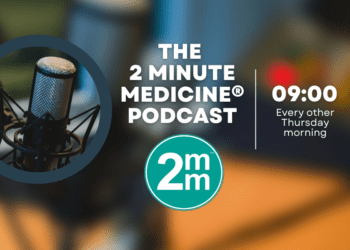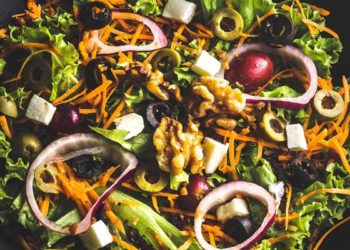Wellness Check: Nutrition
Yogurt intake may be associated with a lower risk of obesity during the menopausal transition
1. In this prospective cohort study, higher yogurt intake was associated with lower weight gain and obesity risk in women during the menopausal transition.
2. Additionally, women with higher yogurt intake also had higher activity levels and overall healthy eating index scores that were independently associated with a lower risk of obesity.
Evidence Rating Level: 2 (Good)
Due to hormonal changes, the time surrounding menopause can often be associated with weight gain. Although, diet also plays a large contributory role in the association between menopause and weight gain. Although the effects of dairy foods on weight gain remain controversial, some large cohort studies observed that increased yogurt intake was associated with lower weight gain. However, the effect of dairy intake on weight gain in the perimenopausal period is unclear. Therefore, this study aimed to investigate the role of dairy products on weight change and risk of obesity during the menopausal transition.
This large cohort study was part of the Nurses’ Health Study II, which included 116,429 registered nurses aged 25-42 years at the time of the study’s launch in 1989. Participants were followed using questionnaires every 2 years. Participants were excluded from this study if they died before menopause, had a nonnatural menopause, had menopause before the age of 45 years, had cancer, diabetes, or cardiovascular disease, or if their age at menopause was missing. Self-reported weight data was collected for the 12 years surrounding menopause, from 3 exams before and 3 exams after menopause occurred. The amount of dairy intake was estimated as the mean intake over the same 12 years as recorded in a Food Frequency Questionnaire (FFQ) administered every 4 years. The primary outcome was weight change in the 12 years surrounding menopause.
The results demonstrated that women with the highest yogurt intake (≥2 servings/week) had the lowest adjusted weight gain and a 31% lower risk of obesity during the menopausal transition. However, this same association was not seen for other dairy products. Higher yogurt intake was also associated with an overall healthier lifestyle, such as increased exercise, but was still independently associated with lower obesity risk. This study was limited by the potential for reporting bias, given that dairy intake and weight measurements were both self-reported. Nonetheless, these results indicated that yogurt may be beneficial in reducing weight gain and obesity risk in the perimenopausal period.
Carbohydrate quantity and quality may influence plasma concentrations of some saturated fatty acids
1. In this randomized controlled trial, carbohydrate quantity and quality did not significantly change plasma concentrations of palmitate, a type of saturated fatty acid.
2. However, plasma concentrations of myristic acid were higher after consumption of a high-carbohydrate/high-sugar diet compared to a low-carbohydrate diet.
Evidence Rating Level: 1 (Excellent)
The concentration of saturated fatty acids (SFAs) that are synthesized endogenously from carbohydrates through the process of de novo lipogenesis (DNL) is known to be associated with cardiometabolic risk. However, how different dietary patterns of carbohydrates affect plasma concentrations of DNL SFAs, such as palmitate and myristic acid, has not been well studied. Therefore, the purpose of this study was to assess the effects of carbohydrate quantity and quality on plasma concentrations of SFAs.
This randomized control trial included 18 healthy Swedish adults (50% female). Participants aged 20-75 years who had a BMI between 20-38kg/m2 were included. Participants who had abnormal lab tests, weight changes ≥3kg during the 3 months preceding the study screening, or diabetes, cardiovascular, kidney, liver, or malignant disease were excluded. Each participant was randomized to one of three diets for 3 weeks: low-carbohydrate (LC), high-carbohydrate/high-fiber (HCF), and high-carbohydrate/high-sugar (HCS). This was followed by a 1-week washout period and then randomization into another of the three diets until all participants had undergone all study diets. The primary outcome was plasma concentrations of SFAs, including palmitate, in cholesterol ester (CE), phospholipid (PL), and triglyceride (TG) lipid fractions.
The results demonstrated that carbohydrate quantity and quality did not influence the levels of plasma palmitate in all three plasma lipid fractions. However, the concentration of the SFA myristate in CE and PL lipid fractions increased after the HCS diet compared to the LC and HCF diets. This study was limited by the relatively short intervention period of three weeks and the potential for deviation from the prescribed diets. Nonetheless, the study indicated that carbohydrate quantity and quality may impact some plasma SFA concentrations more than others.
Nut consumption may be inversely associated with frailty in older women
1. In this prospective cohort study, increased consumption of nuts was associated with a lower risk of frailty in women over 60 years old.
2. In contrast, peanut butter consumption was not associated with a lower risk of frailty.
Evidence Rating Level: 2 (Good)
Frailty is a condition of increased vulnerability to stressful events and often disproportionately affects women and long-term care facility residents. The Mediterranean diet is known to be inversely associated with risk of frailty. Nuts are an important part of the Mediterranean diet, however the association between this food group and the beneficial effects on frailty are unclear. Therefore, the purpose of this study was to investigate the role of nut consumption on frailty risk in older women.
This cohort study included 71,704 nonfrail females ≥60 years old from 11 US states. Participants with unreasonably high or low caloric intake or missing data on their nut consumption were excluded. Participants were surveyed every 2 years from 1992 to 2016 on factors such as weight and health status. Nut consumption was evaluated using a Food Frequency Questionnaire administered every 4 years. The primary outcome was frailty, defined as having ≥3 of the FRAIL frailty scale components, which include fatigue, lower strength, reduced aerobic capacity, multiple chronic conditions, and significant weight loss.
The results demonstrated that higher nut consumption was associated with lower risk of frailty. This association remained after adjustment for lifestyle factors. However, consuming higher amount of peanut butter was not associated with reduced risk of frailty. This study was limited by possible inaccuracies in nut consumption and FRAIL frailty scale score given the self-reported nature of the study. Nonetheless, this study provided initial evidence indicating the role of nut consumption in reduced frailty risk.
Image: PD
©2023 2 Minute Medicine, Inc. All rights reserved. No works may be reproduced without expressed written consent from 2 Minute Medicine, Inc. Inquire about licensing here. No article should be construed as medical advice and is not intended as such by the authors or by 2 Minute Medicine, Inc.







